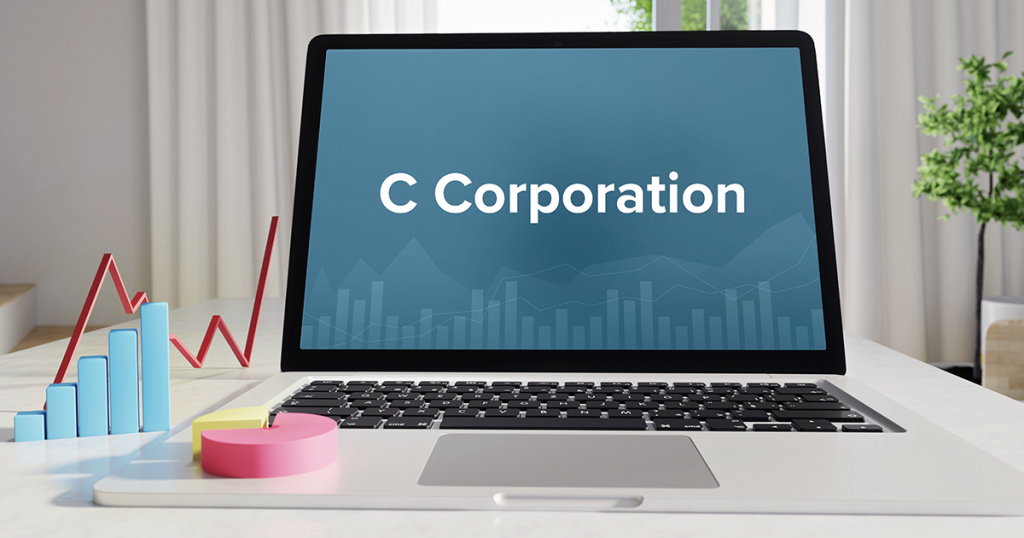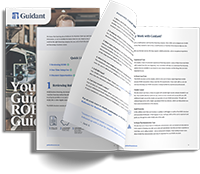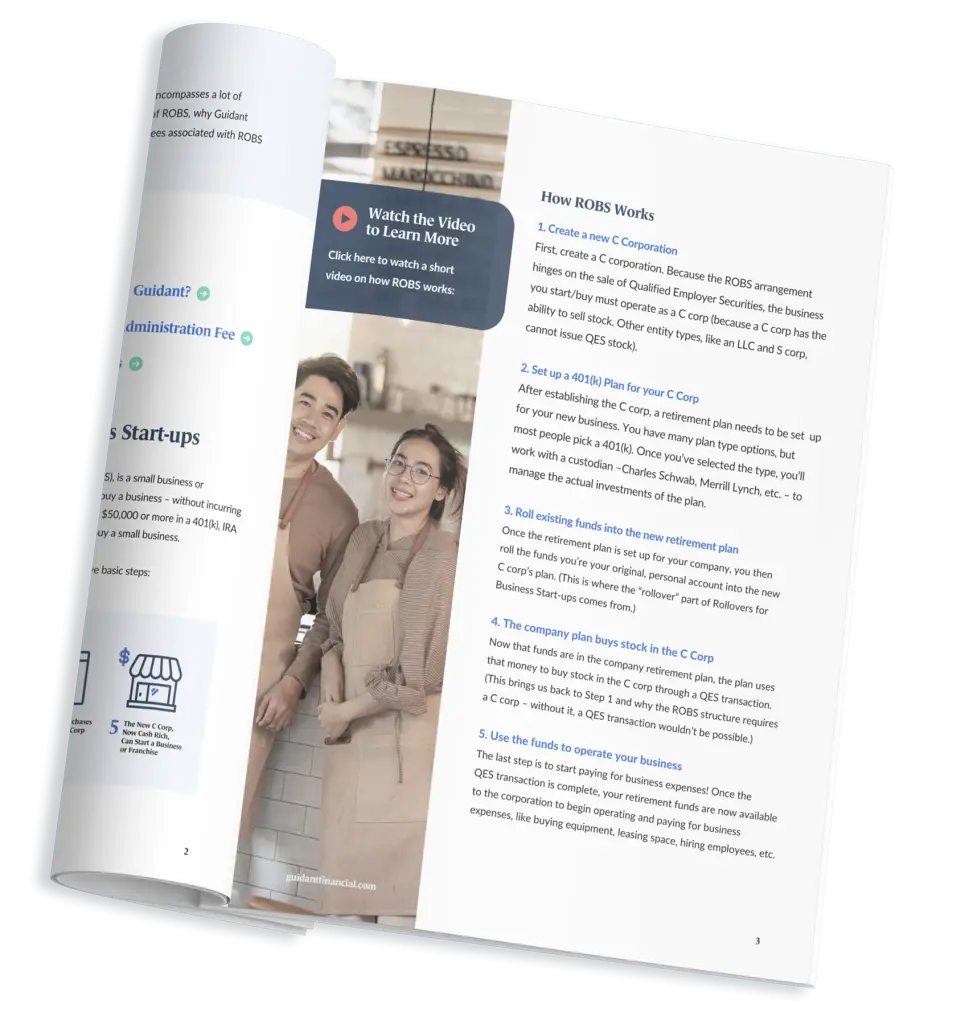Can you change your business entity from S Corp to C Corp?
Is your business an S Corporation (S Corp)? Do you want to change it to a C Corporation (C Corp) — but you’re unsure how to get started or if it’s even possible? Here’s the good news: You can convert an S Corp to C Corp!
But before we go into how to change your S Corp to C Corp, let’s go over why you might want a C Corp business entity.
Some small business owners prefer the tax benefits and structure of a C Corp. C Corps also enjoy fewer ownership restrictions than S Corps. For example, C Corps can have unlimited shareholders, whereas S Corps limits your shareholder amount to 100. And changing your business entity from S Corp to C Corp allows for more flexible funding options.
To use 401(k) business financing, also known as Rollovers for Business Startups (ROBS), your company must be a C Corporation (C Corp). Why? For one, the Internal Revenue Service (IRS) carefully regulates ROBS. And ROBS can only work through the sale of Qualified Employer Securities (QES), which only C Corps can do!
What’s a C Corporation — and is it the right structure for your business? Here’s everything you need to know about C Corps.
What’s 401(k) Business Financing (AKA “ROBS”)?
ROBS lets you withdraw your retirement money early and tax penalty-free to fund your business ventures. And it’s not a loan. ROBS simply allows you to use your 401(k) money for business financing, so you can start or fund your business debt-free. That’s why ROBS is becoming an increasingly popular funding method among small business owners.
Why Does ROBS Only Work for C Corps?
If a business owner wants to use their 401(k) or IRA money to start a business, they can follow specific steps to set up a ROBS plan. The first step? You guessed it: The business must be registered as a C Corp.
Second, you establish a new retirement plan for the C Corp, often a 401(k). Once that’s done, you can roll your retirement funds over into your business’s retirement plan. After that, the new retirement plan purchases stock in the C Corp through a QES sale. The business can now use the stock for any business purpose. This process allows you to avoid taxes and penalties for withdrawing your retirement funds early.
But don’t worry if your business is an S Corp! You can convert your S Corp to C Corp and reap the advantages of ROBS, as well as many other advantages C Corps offer. We mentioned some of these benefits earlier, but continue reading for a closer look at C Corps!
Does your retirement plan qualify for 401(k) business financing? Here are 10 Types of Eligible Retirement Funds for ROBS 401(k) Business Financing.
What Are the Differences Between an S Corp and a C Corp?

Let’s run through some differences between an S Corp and a C Corp — so that you can make an informed decision about whether it’s best to change your existing business structure or not!
More Funding Options with C Corps
C Corps can make it easier to access more flexible funding options, like ROBS. As we mentioned earlier, ROBS lets you gain complete control over your qualified retirement funds for business financing. (The most common retirement plan types, such as 401(k)s and Individual Retirement Accounts (IRAs), are qualified for ROBS!)
ROBS as a funding option is becoming increasingly popular, especially as we enter the era of rising prices and interest rates. Paying and accruing a large monthly debt can significantly set your business back. That’s why many aspiring and current business owners choose ROBS over standard business loans.
Getting approved for a business loan can also be rigorous and challenging. U.S. Small Business Administration (SBA) Loans often have a rigorous and competitive application process. And depending on your lender, you may have to meet specific credit-score requirements to even be considered for approval. So, ROBS is a great option to get the funding you need when other funding methods don’t work out.
ROBS can also be used with SBA loans and other financing options. For example, you can use ROBS as a down payment for a loan to maximize its amount.
Additionally, C Corps have an excellent reputation among lenders and can be considered a safer choice for investors. C Corps are often perceived as more stable than S Corps, partly because of their often larger size. (The best-known companies in the U.S. are mostly C Corps!) But C Corps also require a more organized business structure and opportunistic requirements, like holding regular board of director meetings. All of this can convince lenders that you have the business standing and character to receive a loan more than other business entity types.
A C Corp is also a good choice for raising capital through stock, especially if you don’t want shareholder restrictions — and may benefit from multiple classes of stock! While an S Corp can have shareholders, the number cannot exceed 100. Remember: A C Corp has no limitations to the number of corporate shareholders it can have! S Corps are also not permitted to issue multiple classes of stock, while C Corps are.
How does 401(k) business financing work? See our Complete Guide to 401(k) Financing: Rollovers as Business Startups (ROBS).
Tax Benefits of C Corps and S Corps
The tax treatment of a C Corp and an S Corp is very different. Many small business owners choose S Corps for its tax status. Why? S Corp income is treated as pass-through income. In other words, all company profits — as well as losses, deductions, and other credits — are passed through to individual shareholders in the S Corp. (S Corps are also known as pass-through entities for this reason!)
All shareholders report the pass-through on individual tax returns at a personal tax rate. So, there’s no Federal corporate tax paid in an S Corp.
This can be a big perk for some businesses — and is one of the reasons S Corps have been a fast-growing business entity over the past several decades. (Be wary that your state may levy taxes on an S Corp, and that you don’t necessarily pay fewer taxes as an S Corp!)
A C Corp., on the other hand, does pay a corporate tax on profits and losses. In addition, employees pay individual income tax on their salaries, and any owners of dividends pay taxes on the dividends. The existence of both a corporate tax and personal tax on income is often termed “double taxation.” Note that “double taxation” doesn’t mean you pay double the taxes as a C Corp!
It’s crucial to understand these key tax differences before changing your business entity structure. But remember that avoiding Federal tax alone doesn’t always make an S Corp the better choice. Corporate tax rates can be lower than personal tax rates.
The amount of tax paid and the calculation of benefits and drawbacks is complicated. It also depends on your company’s profit and loss picture, tax credits and deductions, the number of corporate shares you have, and more.
Tip: Consult an accountant if you want more insight on converting from S Corp to C Corp! Professionals can help you determine, with careful consideration, the business structure that best fits your company.
A final note on taxation: A C Corp can be less subject to audits than an S Corp, particularly in an era when the IRS has received more funding to scour corporate tax records. S Corp taxation, particularly the treatment of losses as an offset to income, may easily trigger an audit.
What Are the Similarities Between an S Corp and a C Corp?
S Corps and C Corps are similar in some ways as well. Both types of business entities offer legal liability for business owners. You personally are not liable in the event of corporate bankruptcy or legal judgment, for instance; the corporation is. Your personal assets are thus protected.
S Corps and C Corps also have very similar governance and structure requirements. They must comply with all Federal and state mandates. Each must have a Board of Directors, bylaws, and officers. If either corporation has issued stock, shareholder meetings must be held and annual reports issued. Financial reports need to be clearly available to the shareholders and regularly issued.
Before deciding to change your business from an S Corp to C Corp, you’ll want to take all the above factors into consideration!
See What’s the Difference Between an S Corp and C Corp? to further compare and understand these business entity types!
How to Convert S Corp to C Corp

Now that you’ve decided to change your business entity, let’s break down the steps of converting your business from S Corp to C Corp!
- Create a “Statement of Revocation” and submit it to the IRS Service Center where you initially filed for S Corp status. There’s no specific form for a Statement of Revocation. Still, it must state that you wish to revoke the S Corp status election made under Section 1362(a). The statement must also include information on your company, including its:
- Name and tax ID number
- The date on which your tax year ends
- The date of the revocation
- The number of outstanding shares
- If your S Corp has shareholders, you need to include their names, addresses, tax ID numbers, and the number of shares they hold. You must also submit a statement of consent signed by corporate shareholders who, in total, own more than 50 percent of company stock — whether the shares are voting or nonvoting.
- The Statement of Revocation needs to be completed and signed by the person authorized to sign your corporate tax returns. Note that you can turn in your Statement of Revocation at any time. Usually, it takes a month or less once all the documents are complete, signed, and submitted.
Warning! Changing the corporate structure can sometimes be the best and easiest to do on the first day of your tax year. If so, note that you must submit a completed Statement of Revocation by the 15th day of the tax year’s third month. It will become effective on the first day of the following tax year unless submitted by that date!
Tip: Having a lawyer draw up your Statement of Revocation is a good idea to avoid errors and save time. Plus it’ll make the whole process easier!
Guidant Financial Can Help
Are you looking to expand your financing options using your 401(k)? Whether you choose to use 401(k) business financing, a business loan, or a combination of the two, Guidant can help you get the money you need to start or grow your business!
Setting up a C Corp with ROBS is complex, and the change can trigger taxes and penalties if done incorrectly. That’s why we’ll walk you through each step to make sure it’s done right the first time, following important IRS rules.
In the end, you can have a funded C Corp with a new retirement plan — and your own business. Contact us at 888-472-4455 to schedule a free consultation or pre-qualify now for business financing!
Hear how our clients used ROBS to start their dream businesses.

















